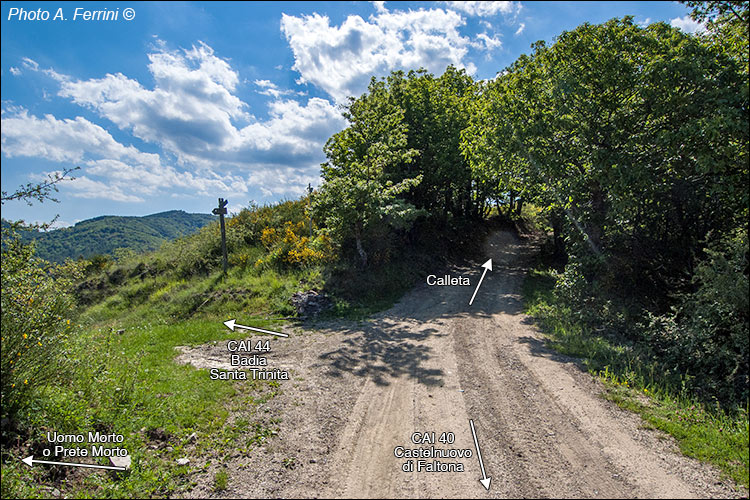Carda
in Casentino, una bella valle Toscana che puoi conoscere in ogni suo dettaglio con questo sito
Italiano
CARDA E BADIA SANTA TRINITA
Passo alla Forca, 1065 metri di quota. Siamo a trecento metri, verso nord, dal punto da cui avevamo la vista sul Casentino e su Carda (pagina precedente). Il percorso che volta a sinistra (CAI 44) in settecento metri scende ai ruderi di Badia Santa Trinita, 952 metri. Il monastero benedettino, primo a sorgere in tutta la zona Casentino, Arezzo, Valdarno attorno al 960, è inscindibile dalla storia di Carda in quanto i Conti Ubertini, padroni del luogo, attorno al 1360 lo donarono ai monaci di Santa Trinita. Nacque un legame molto forte tra questi due luoghi (anche per la vicinanza) che si protrasse fino a che l'abbazia rimase proprietà vallombrosana (subordinazione che cessò ad inizio XIX secolo con le soppressioni napoleoniche). Fino agli anni Sessanta del Novecento, la strada che sale a Passo alla Forca da Santa Trinita, poi scendeva dritto dalla parte opposta (a destra nella foto). Non più utilizzato perché sostituito da una pista forestale ottocento metri più avanti (attuale CAI 38), questo percorso è stato "cancellato" dalla vegetazione, ma nella carta catastale odierna la strada è ancora segnata, così come è presente in una mappa del 1824. È ed era indicata come Strada del Valdarno. Si trattava di una via di comunicazione molto importante tra questa valle ed il Casentino.
A Passo alla Forca si trova un cumulo di pietre chiamato Uomo Morto o Prete Morto. Ecco perché.
Passo alla Forca, 1065 meters above sea level. We are three hundred meters, to the north, from the point from which we had a view of Casentino and Carda (previous page). The path that turns left (CAI 44) descends in seven hundred meters to the ruins of Badia Santa Trinita, 952 meters. The Benedictine monastery, the first to arise in the entire Casentino, Arezzo, Valdarno area around 960, is inseparable from the history of Carda since the Ubertini Counts, owners of the place, donated it to the monks of Santa Trinita around 1360. A very strong bond was born between these two places (also due to their proximity) that lasted until the abbey remained a Vallombrosan property (subordination that ceased at the beginning of the 19th century with the Napoleonic suppressions). Until the 1960s, the road that goes up to Passo alla Forca from Santa Trinita, then went straight down the opposite side (on the right in the photo). No longer used because it was replaced by a forest track eight hundred meters further on (current CAI 38), this route has been "erased" by vegetation, but in today's land registry map the road is still marked, as it is on a map from 1824. It is and was indicated as Strada del Valdarno. It was a very important communication route between this valley and Casentino.
At Passo alla Forca there is a pile of stones called Uomo Morto or Prete Morto. Here's why.

















































